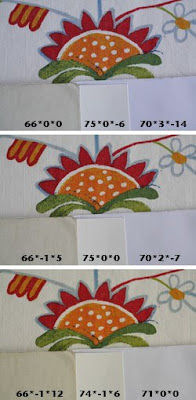 Custom white balance (CWB) setting for correct gray balance in the camera is a very powerful tool when being used correctly.
Custom white balance (CWB) setting for correct gray balance in the camera is a very powerful tool when being used correctly.The problem is that white isn't always white when it comes to spectrophotometric definition. "Point the camera at a white surface and set CWB" just isn't enough for a photographer who wants to get it right. The problem is illustrated in the picture below.
There are three different white surfaces in the picture. From left to right: An old slightly yellowish backside of a Kodak 18% gray card. The white patch on QPcard 101. An envelope from the mail.
The camera always assumes the surface it is being pointed at when setting CWB is neutral. By pointing the camera at the left "white" surface, the whole picture becomes bluish. Many white papers are bluish, like the envelope to the right, which gives a warm tint to the picture.
In order to set CWB correctly it is necessary to point the camera at a perfectly neutral surface, like QPcard 101.
The numbers in the picture are L*a*b values measured in Adobe Photoshop. "L" is lightness, "a" is red or green, "b" is yellow or blue. 0 (zero) for a and b means neutral, with no tint of any color.




